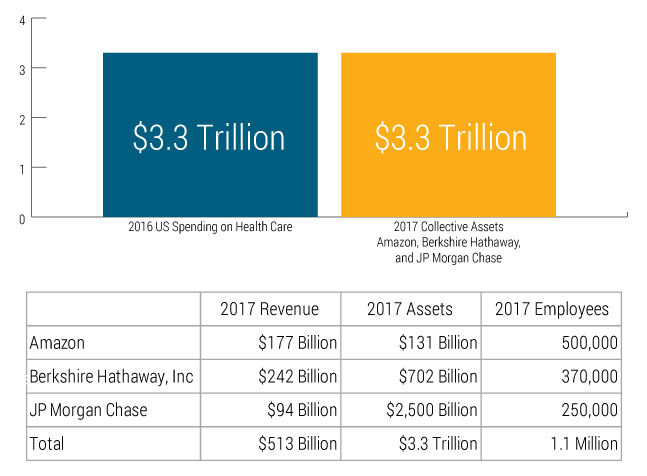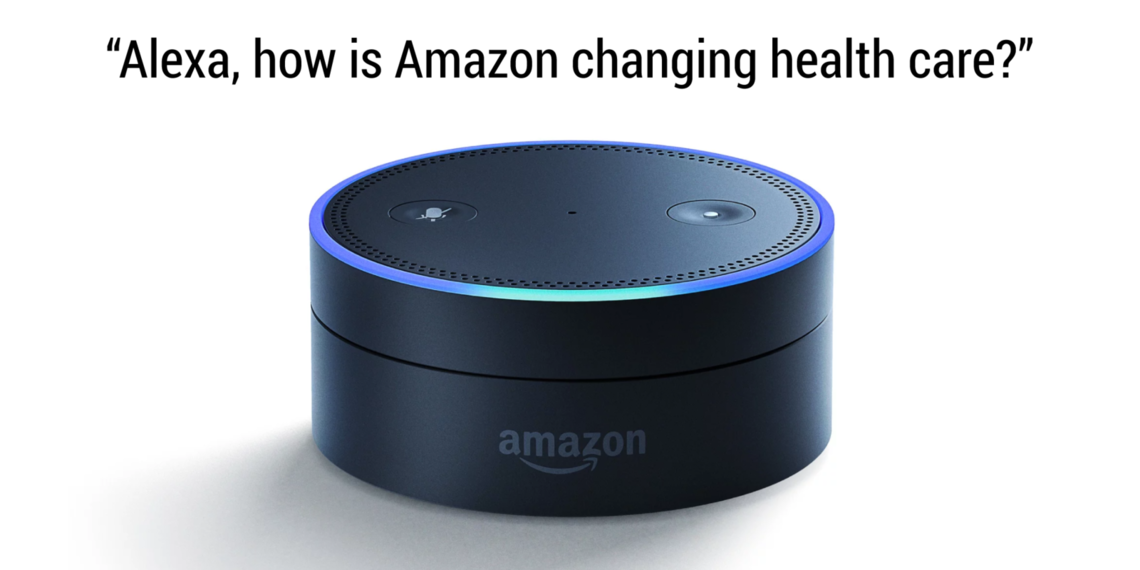What happened?
On January 30th, 2018, Amazon’s Jeff Bezos, Berkshire Hathaway’s Warren Buffett, and JP Morgan Chase’s Jamie Dimon announced a new partnership to address the health care crisis. With a stated aim of “improving employee satisfaction and reducing costs,” the three companies plan to “provide US employees and their families with simplified, high-quality, and transparent health care at a reasonable cost”—all while operating “free from profit-making incentives and constraints.”
While Amazon, Berkshire Hathaway, and JP Morgan Chase are not the first companies to proclaim a desire to decrease their health care costs and disrupt the marketplace, this unique combination of partners deserves our attention. If anyone can tackle such an enormous challenge, it’s these three titans of their respective industries.
US Spending on Health Care in 2016 v. 2017 Assets for Amazon & Friends

Founded in 1994, Amazon is the newest of the three companies involved in this venture. However, Amazon’s assets exceed $131 billion and it employs more than 500,000 people. Berkshire Hathaway boasts far more in assets—$702 billion—and employs 370,000 people, while JP Morgan Chase boasts $2.5 trillion in assets and employs 250,000. Together, these three companies employ more than a million people and have more than $3 trillion dollars in assets to support whatever project, venture, or company that will emerge from this agreement.
In health care, does size matter?
Yes and no.
It’s not that “might makes right” in the health care industry. As illustrated above, size matters because these groups have ample reserve capital and long-term thinking embedded in their strategies.
This partnership signals something new: an attempt to build fresh internal approaches to health care spending, rather than a venture capital-driven tactic to immediately maximize investments. If Amazon, Berkshire Hathaway, and JP Morgan Chase reduce or level out their own health care costs, their strategy could potentially serve as a blueprint for other large employers. Given that possibility, coupled with the vast resources available to them, then yes, size could matter.
Or it could not—one million employees are a lot, but they represent an incredibly small portion of overall health care costs across the country. Even if Amazon, Berkshire Hathaway, and JP Morgan Chase do discover a way to reduce their own internal costs, it’s still difficult to span the chasm from internal cost-cutting to influencing the broader health care environment.
That said, if the three companies intend to play the long game and don’t have to worry about immediate results beyond their own internal focus, things could play out in several different ways.
“Fix” internal, stay internal
Once they understand the obstacles to expanding into the broader market, Amazon, Berkshire Hathaway, and JP Morgan Chase could pull their resources together, simply decide to tackle internal health care costs, and leave it at that. Given the ambitious nature of their announcement and the reputations of each company, this is the least likely scenario.
“Fix” internal, start own insurance(-ish) plan
While working to reduce their own internal costs, the three companies could feasibly develop a new type of insurance plan or program: one that focuses on the particular needs and issues of operations at large international companies. This is a possible outcome, though not probable.
“Fix” internal, sell technology solutions
Given the way Amazon has reinvented the online marketplace—in 2017, they dominated by capturing 44% of all online sales in the US—this new venture could develop into a technology magnet for other elements of the health care industry. This seems to be the most likely outcome, especially since Amazon possesses the know-how and capabilities to reshape the way customers interact with embedded systems. Paired with Berkshire Hathaway’s involvement in health care reinsurance (essentially, a backstop for health insurance companies) and JP Morgan Chase’s financing arm, this seems like a plausible end-point.
The exact nature and timing of such a development is unknown. First, these three companies will have to figure out how to bend their own cost curves before others will be drawn to any external plans they offer. The technologies that Amazon, Berkshire Hathaway, and JP Morgan could employ range from:
- Simply having better, more actionable data to track and reduce their costs
- Creating a system to automatically track and negotiate or reduce health care expenses
Talk about a wide-open scenario.
Tempered projection
Some have jumped to extremes when examining the possible influence of this partnership on health care as a whole. Given the size of the three companies involved, their available investment capital, and the possibility of an entirely new company driving innovation, the long-term approach taken by Amazon, Berkshire Hathaway, and JP Morgan Chase could change the underlying health care landscape.
Will hospitals and clinics deliver more care via telehealth? Will that negatively or positively impact patients? No clear answers exist yet. The bigger shift will come from the way that consumers interact with health care systems—and the way those systems interact with individual consumers, as well.
Zac Watne
Improvement work isn’t easy, especially when it attempts to address rising health care costs. Solid organ transplant coordinator Sharon Ugolini and her team led award-winning work implementing new protocols for common tests. That led to more than just reduced patient charges, though — ordering appropriate tests increases value and quality, as well.
We asked Zac Watne, Utah’s payment innovation manager (he gets paid to understand the volatile world of payment reform) to give us a primer on “bundles.” Regardless of change happening in health care, thought leaders predict that payment reform, and specifically, bundled payments, are here to stay. Why? Bundles deliver care with improved outcomes at a lower price all over the United States. In this post, Zac outlines the difference between voluntary and mandatory bundles.
When health care is designed around patient needs, it doesn't just benefit the patient — it can also help providers find fulfillment in their work. But what does that look like in practice? Physician Joy English opened the Orthopaedic Injury Clinic, an innovative service that delivers better value to patients. Her success is a case study in how to achieve both provider and patient happiness.
